Art in the Ottoman Empire in the 17 Century
| Clockwise from peak: Nuruosmaniye Mosque (1748–1755); Sebil of the Mihrişah Sultan Complex (1792–1796); Mausoleum of Mustafa Three at the Laleli Mosque (1760–1764) | |
| Years active | 1740s to 1820s |
|---|---|
Ottoman Bizarre architecture was a menses in Ottoman architecture in the 18th century and early on 19th century which was influenced past European Baroque architecture. Preceded by the changes of the Tulip Period, the style marked a meaning difference from the classical mode of Ottoman architecture and introduced new decorative forms to mostly traditional Ottoman edifice types. The style emerged in the 1740s during the reign of Mahmud I (1730–1754) and its almost important early monument was the Nuruosmaniye Mosque completed in 1755. Later in the 18th century new building types were too introduced based on European influences. The last fully Baroque monuments, such every bit the Nusretiye Mosque, were congenital by Mahmud Ii (r. 1808–1839) in the early 19th century, but during this catamenia new European-influenced styles were introduced and supplanted the Bizarre.
Background [edit]
From the 18th century onward European influences were introduced into Ottoman architecture as the Ottoman Empire itself became more open to exterior influences. The term "Baroque" is sometimes applied more widely to Ottoman fine art and architecture across the 18th century including the Tulip Flow.[i] [2] In more specific terms, nonetheless, the period after the 17th century is marked by several different styles.[3] [four] The Ottoman or Turkish "Bizarre" style emerged in its full expression during the 1740s and quickly replaced the style of the Tulip Period.[5] [3] This shift signaled the final finish to the previous classical manner which had dominated Ottoman compages in the 16th and 17th centuries.[6] The political and cultural conditions which led to the Ottoman Baroque trace their origins in part to the Tulip Menstruum, during the reign of Ahmed III, when the Ottoman ruling class opened itself to Western influence.[iii] [vii] Afterward the Tulip Menstruation, Ottoman architecture openly imitated European architecture, so that architectural and decorative trends in Europe were mirrored in the Ottoman Empire at the same time or after a brusk filibuster.[8] Changes were particularly evident in the ornamentation and details of new buildings rather than in their overall forms, though new building types were eventually introduced from European influences as well.[2] The term "Turkish Rococo", or simply "Rococo",[half dozen] [nine] is also used to depict the Ottoman Bizarre, or parts of it, due to the similarities and influences from the French Rococo style in particular, but this terminology varies from author to author.[x]
Developments [edit]
First Baroque monuments (1740s) [edit]
The start structures to exhibit the new Baroque style are several fountains and sebils built past elite patrons in Istanbul in 1741–1742: the fountain of Nisançı Ahmed Pasha added to the southwest wall of the Fatih Mosque cemetery, the Hacı Mehmet Emin Ağa Sebil almost Dolmabahçe, and the Sa'deddin Efendi Sebil at the Karaca Ahmet Cemetery in Üsküdar.[11] The Baroque-style Cağaloğlu Hamam in Istanbul was besides congenital in the same year and was sponsored by Mahmud I, demonstrating that even the sultan promoted the style.[12] The revenues of this hammam were earmarked for the Hagia Sophia (Ayasofya) Mosque, where Mahmud I built several new annexes and additions. These additions included a domed ablutions fountain in 1740–41 that is decorated with Baroque motifs merely all the same maintains a traditional Ottoman form overall.[13] [xiv] More indicative of the new mode is the imaret that Mahmud I added in the northeastern corner of Hagia Sophia's precinct in 1743. The imaret has an extravagantly Baroque gate which is carved with loftier-relief vegetal scrolls and a spiralling "swan-neck" pediment, flanked by marble columns with Corinthian-like capitals, and surmounted by wide eaves.[xv]
Godfrey Goodwin, a scholar of Ottoman compages history, suggests that the külliye which most clearly demonstrates the transition betwixt the old and new styles was the Beşir Ağa Mosque and its sebil, built in 1745 near the western perimeter of Topkapı Palace.[16] Ünver Rüstem argues that the rapidity with which the style appeared across Istanbul after 1740 and the fact that the first Baroque structures were all commissioned by high-ranking elites should exist interpreted as a deliberate endeavour by the sultan and his courtroom to promote the new style.[17] Scholar Doğan Kuban states that Baroque motifs spread gradually from one architectural element to another, progressively replacing the sharper geometric ornamentation of the classical era with more dynamic curved forms such as the "South" and "C" curves and eventually with even more flamboyant European Baroque elements.[18]
- Early Bizarre monuments
-
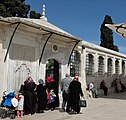
Archway to the Fatih Mosque'due south cemetery, with the Fountain of Nisançı Ahmed Pasha (1741–42) on the far left
-
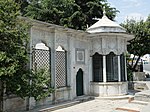
Hacı Mehmet Emin Ağa Sebil, Istanbul (1741–42)
-
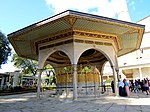
Fountain of Mahmud I at Hagia Sophia, Istanbul (1740–41)
-

Gate to the imaret of Hagia Sophia, Istanbul (1743)
-
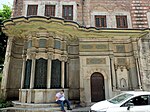
Sebil of the Seyyid Hasan Pasha complex, Istanbul (1745)[19]
The Nuruosmaniye complex [edit]
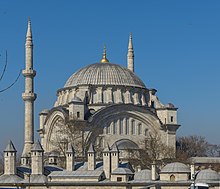
The most important monument heralding the new Ottoman Bizarre style is the Nuruosmaniye Mosque complex, begun by Mahmud I in October 1748 and completed by his successor, Osman III (to whom it is defended), in Dec 1755.[xx] Kuban describes information technology every bit the "most important monumental structure later the Selimiye Mosque in Edirne", marking the integration of European culture into Ottoman architecture and the rejection of the Classical Ottoman style.[19] It as well marked the commencement time since the Sultan Ahmed I Mosque (early 17th century) that an Ottoman sultan built his own imperial mosque complex in Istanbul, thus inaugurating the return of this tradition.[21] Historical sources adjure that the architect in charge was a Christian chief carpenter named Simeon or Simon.[22] [23] [24] Simeon'south chief banana was a Christian man named Kozma and the bulk of the stonemasons under him were Christians equally well. Both Simeon and Kozma were given robes of honour by the grand vizier at the mosque'southward opening ceremony. Ünver Rüstem notes this may accept been the commencement time Christian architects were officially honoured in this mode at the inauguration of a mosque and that it reflected the growing condition of Christian craftsmen during this era.[24]

Elevation and floor plan of the Nuruosmaniye Mosque (from drawings by Cornelius Gurlitt)
The mosque consists of a square prayer hall surmounted by a large single dome with large pendentives. The dome is one of the largest in Istanbul,[25] measuring 25.75 meters in diameter.[26] From the outside, the dome sits above four huge arches (ane for each side of the square) pierced with many windows that provide calorie-free to the interior. The closest precedent to this blueprint in Classical Ottoman architecture is the Mihrimah Sultan Mosque in the Edirnekapi neighbourhood.[27] [28] The projecting apse which contains the mihrab is besides comparable to the Selimiye Mosque in Edirne.[27] The details and decoration of the mosque are firmly Baroque. For example, the curving pediments above the exterior arches have concave flourishes at their edges, while the windows, doorways, and arches of the mosque have mixtilinear (i.e. combination of different curves) or round profiles instead of pointed arch profiles.[29] [30] The central doorway of the courtyard is topped by an unusual radiating dominicus motif carved in rock while the other doorways accept pyramidal semi-vaults which, instead of the traditional muqarnas, are carved with many rows of acanthus-like friezes and other motifs – a limerick that is neither Ottoman nor European in style.[31] Fifty-fifty more than unusual is the grade of the mosque'southward courtyard, which is semielliptical instead of the traditional rectangular form.[32] Inside, the mosque'due south prayer hall is flanked by symmetrical ii-story galleries that extend exterior the main perimeter of the hall. The corners of these galleries, on either side of the mihrab area, include infinite for the muezzins on one side and for the sultan's loge on the other, thus dispensing with the traditional müezzin mahfili platform in the heart of the mosque. This gallery organisation leaves the central infinite unencumbered while still dissimulating the supporting piers of the dome.[33] The virtually exuberant Baroque carvings, such as flutes and coil forms, are constitute on the minbar.[34] The hood of the mihrab, like the semi-vaults above the exterior doorways, is carved with a mix of eclectic friezes that replace the traditional muqarnas.[35] The mosque'due south stone ornamentation also establishes a new mode of capitals that distinguishes the Ottoman Bizarre: a vase or inverse bell shape, either plain or decorated, usually with minor but prominent volutes at its corners, similar to Ionic capitals.[36] [37]
Similar earlier royal foundations, the mosque formed the center of a complex consisting of several buildings including a madrasa, an imaret, a library, a royal tomb, a sebil and fountain, and an imperial pavilion (Hünkâr Kasır), most of which are equally Baroque.[38] [39] The sebil and fountain that flank the western gate of the complex have curved and flamboyant forms counterbalanced past the plain walls around them, which Goodwin calls the "epitome of the baroque" style for these features.[40] The library in the northeastern corner is distinguished by undulating curves and a roughly elliptical interior. The tomb, which houses the remains of Şehsuvar Sultan, has ornate moldings and concave cornices.[41] At the eastern corner of the mosque is an Fifty-shaped structured which consists of a covered ramp leading to an imperial pavilion. This kind of feature get-go appeared in the 17th century with the Sultan Ahmed I Mosque and was farther exemplified by the Hünkâr Kasrı of the New Mosque in Eminönü. At the Nuruosmaniye, however, this pavilion is more detailed, more prominent, and more deliberately integrated into the rest of the complex.[41] [42] It was used equally a private lounge or reception area (selamlık) for the sultan when visiting the mosque and gave him direct access to the sultan's loge inside the mosque.[43] Considering such imperial pavilions were closer to the public heart than the imperial palace, they played a part in enhancing the sultan'southward public presence and in staging some public ceremonies.[44] Accordingly, the construction of majestic pavilions as part of imperial mosques aligned itself with the cultural shift taking identify in the 18th century effectually the sultan's official displays of power, and such regal pavilions became always more prominent in later royal mosques.[45]
- Details of the Nuruosmaniye complex
-
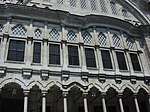
Mixtilinear arches in the lateral portico and windows of the mosque
-

Semi-vault to a higher place 1 of the mosque entrances, with Bizarre friezes replacing muqarnas
-

Courtyard of the mosque
-

Interior of the mosque
-

Baroque details of the minbar within the mosque
-
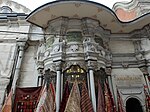
Sebil of the circuitous
-
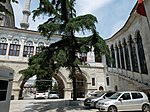
Imperial pavilion: a ramp on the right leads to a private lounge connected to the mosque on the left
-
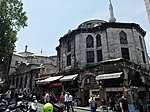
The tomb (left) and library (right) of the complex
Reign of Mustafa Three [edit]
Mustafa III (r. 1757–1774), successor of Osman 2 and a son of Ahmed Three, engaged in many building activities during his long reign.[46] His showtime foundation was the Ayazma Mosque in Üsküdar in honour of his mother. Construction began in 1757–1758 and finished in 1760–1761.[47] [48] It is substantially a smaller version of the Nuruosmaniye Mosque, signalling the importance of the Nuruosmaniye as a new model to emulate.[49] It is richly busy with Baroque carved stonework, especially in the mihrab and minbar.[50] While the mosque is smaller than the Nuruosmaniye, it is relatively alpine for its proportions, enhancing its sense of meridian. This trend towards height was pursued in after mosques such equally the Nusretiye Mosque.[51] The Ayazma Mosque differs from others mainly in the unique organization of its front end façade, which consists of a five-biconvex portico reached past a wide semi-round staircase.[52] [49] This arrangement is similar to another contemporary mosque built in Aydın in 1756, the Cihanoğlu Mosque.[47] The latter is also an example of Baroque elements appearing exterior Istanbul in the mid century.[53] Ane minor detail of the Ayazma Mosque that was recurrent in the 18th century is the small birdhouse carved in rock on the exterior. Such birdhouses were made in the preceding century but in the Baroque period they go more ornate and are commonly attached to the exteriors of both religious and civil buildings.[54]

Mustafa III'south own imperial mosque was built in the center of Istanbul and is known every bit the Laleli Mosque. Its construction began in 1760 and finished in 1764.[55] [56] Its architect was Mehmed Tahir Agha.[56] Due to the sultan's personal wishes, its form is based on that of the Selimiye Mosque in Edirne, consisting of a primary dome supported by eight piers and four corner semi-domes, thus differing significantly from the Nuruosmaniye's design.[57] [58] However, unlike the Selimiye Mosque, the piers are more than slender and are more often than not integrated direct into the walls. The mosque'due south courtyard is rectangular again, leaving the Nuruosmaniye's semi-elliptical courtyard every bit an experiment that was non repeated. The ornamentation is likewise firmly Bizarre, with Ionic-like capitals, round and mixtilinear arches, a mihrab similar to the Nuruosmaniye'south, and other Baroque motifs.[59] [37] [60] The result is a mosque that incorporates the visual style of the Nuruosmaniye in a more than restrained way and integrates it more closely with traditional Ottoman architecture.[61]
The Laleli Mosque is surrounded past the usual annexes: imperial pavilion, sebil, madrasa, imaret and the tomb of Mustafa 3. More unique, though, is the large artificial platform on which the mosque stands. The substructure of this platform was originally used every bit a storehouse and is now occupied by a market.[62] [59] The complex also includes a caravanserai, the Çukurçeşme Han or Taş Han, which contributed to the mosque's revenues.[63] [64] Mustafa Iii as well built another caravanserai, the Büyük Yeni Han, at effectually the aforementioned time (in 1764) in the urban center's central commercial district. It is Istanbul's second-largest caravanserai.[65] Both caravanserais are centred effectually long rectangular courtyards, which was a trend for these blazon of buildings in this catamenia.[63]
The Laleli Mosque is also notable for its apparent Byzantine influences. The walls of the mosque'southward exterior and the walls of its courtyard are constructed in alternating layers of white stone and red brick. This technique was used in early on Ottoman constructions but information technology was largely absent-minded in the subsequently imperial mosques of Istanbul. Along with the use of coloured marble ornamentation inside the mosque, this characteristic may have been a deliberate callback to the city'south ancient Byzantine monuments.[66] This "Byzantinising" trend was not commonplace but did occur in other monuments during the Baroque menstruum. For example, the Mosque of Zeyneb Sultan (Mustafa Iii's sis), congenital in 1769, exhibits an even stronger Byzantine appearance.[67] According to Ünver Rüstem, this miracle may reflect a certain introspection among Ottoman architects of the time almost the city's past and about the connection between Ottoman architecture and Byzantine architecture.[68] This was abetted by the fact that some Baroque motifs evoked forms and motifs that are likewise establish in Byzantine compages, including the Hagia Sophia.[69]
A sense of historical consciousness or historicism in Ottoman compages of the time may be besides evident in Mustafa Iii'south reconstruction of the Fatih Mosque after the 1766 earthquake that partially destroyed information technology. The new Fatih Mosque was completed in 1771 and it neither reproduced the advent of the original 15th-century building nor followed the contemporary Baroque style. It was instead built in a Classical Ottoman style modelled on the 16th-century Şehzade Mosque built by Sinan – whose blueprint had in turn been repeated in major 17th-century mosques like the Sultan Ahmed I Mosque and the New Mosque. This probably indicates that contemporary builders saw the new Baroque style as inappropriate for the advent of an ancient mosque embedded in the mythology of the city's 1453 conquest. At the same time, it showed that Sinan's architecture was associated with the Ottoman golden age and thus appeared as an advisable model to imitate, despite the anachronism.[lxx] By contrast, nevertheless, the nearby tomb of Mehmed Two, which was rebuilt at the same time, is in a fully Bizarre fashion.[71]
- Architecture nether Mustafa 3
-

Cihanoğlu Mosque in Aydın (1756)
-
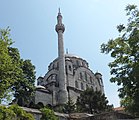
Ayazma Mosque in Üsküdar (1757–1761)
-
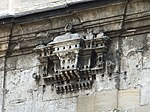
Instance of 18th-century birdhouse on the outside of the Ayazma Mosque
-

Tomb and Sebil of the Laleli Mosque complex
-

Zeynep Sultan Mosque, Istanbul (1769)
-

Fatih Mosque in Istanbul, rebuilt by Mustafa III (completed in 1771)
-
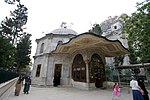
Reconstructed tomb of Mehmed Two backside the Fatih Mosque (circa 1771)
Reign of Abdülhamid I [edit]
During the reign of Abdulhamid I (r. 1774–1789) more strange architects and artists arrived in Istanbul and the Baroque fashion was further consolidated.[72] Abdulhamid I built the Beylerbeyi Mosque (1777–1778) and Emirgan Mosque (1781–82), both located in suburbs of Istanbul on the shores of the Bosphorus, though both were modified by Mahmud II (r. 1808–1839).[73] [74] The Beylerbeyi Mosque is notable for existence oriented towards the water: while some Istanbul mosques had been built along the waterside before, the Beylerbeyi Mosque is the first one which was clearly designed to present its main façade towards the shoreline.[75] [76] The mosque was intended to serve as the sultan'due south prayer space when he was residing in one of his palaces along the Bosphorus.[77] The prayer hall is a traditional single-domed space, but the mosque's most innovative and influential feature is the wide two-story pavilion construction that occupies its front façade, replacing the traditional courtyard or entrance portico. This is an evolution of the regal pavilions which were fastened to the side or back of earlier mosques, taking on a more residential function as a royal apartment and forming an integrated part of the mosque'south appearance. This new configuration was repeated in the design of subsequently imperial mosques.[78] [79]
Abdülhamid built his tomb as part of a charitable complex, the Hamidiye Complex, constructed between 1775 and 1780 in the Eminönü neighbourhood.[eighty] The chief courtroom architect at the time was withal Mehmed Tahir Agha (as it was under Mustafa Iii), simply his role in the design of the Hamidiye complex is not confirmed.[81] The complex lacks a monumental congregational mosque and includes only a small-scale mosque (mescit). Its chief components were instead a madrasa and an imaret, along with the tomb itself and other modest structures. The blueprint of the complex was notable for beingness completely integrated into the pre-existing urban fabric instead of beingness set apart in its own enclosure.[81] The sultan'due south tomb is in Baroque way and one of its notable details is a big Qur'anic inscription band in thuluth script that curves around the interior.[82] Across the street from the tomb was an ornate sebil, only this was relocated near the Zeynep Sultan Mosque after 1911 when the complex was partly demolished to widen the street.[80] The sebil is considered one of the finest examples of Baroque sebils.[46] [72] Its surface shows a greater degree of three-dimensional sculpting, existence profusely carved with scrolls, shells, foliage, and other Baroque moldings. The decoration also demonstrates a greater Rococo tendency, such equally asymmetries in the details of the motifs. These trends came to characterize Ottoman Bizarre architecture in the last quarter of the 18th century.[83] Some other example of the elegant Baroque style in this period is the decorated façade and sebil of the Recai Mehmet Efendi School (1775) almost the Şehzade Mosque.[77]
- Compages under Abdülhamid I
-
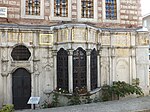
Recai Mehmet Efendi Schoolhouse and sebil, Istanbul (1775)
-
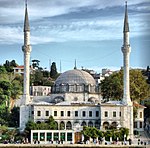
Beylerbeyi Mosque on the Bosphorus, near Istanbul (circa 1778, with later renovations)
-

Sebil of Abdülhamid I, Istanbul (circa 1780)
Reign of Selim 3 [edit]
Selim 3 (r. 1789–1807) was responsible for rebuilding the Eyüp Sultan Mosque betwixt 1798 and 1800.[84] [85] This mosque is located next to the tomb of Abu Ayyub al-Ansari, an of import Islamic religious site in the area of Istanbul originally built by Mehmed 2. The new mosque fabricated use of the Classical Ottoman tradition by following the octagonal baldaquin design, like to the Sokollu Mehmed Pasha Mosque in the Azapkapı neighbourhood, but much of its ornament is in the contemporary Baroque way.[84] [86] [87] Simply the minarets, dating from the reign of Ahmet 3, remain from the previous mosque.[88] [84] In 1804 Selim III too rebuilt the Emir Sultan Mosque in Bursa later on it was damaged by an convulsion (though the new mosque was in turn damaged during the 1855 earthquake). The previous Emir Sultan Mosque's foundations and some of its materials were reused in construction, resulting in a work that mixes primitive and Baroque elements.[89]
Other important Baroque monuments were also built in the Eyüp neighbourhood around this time by Selim III's family unit. Before the reconstruction of the mosque, Mihrişah Sultan (Selim III's mother), built a charitable complex nearby in a vibrant Baroque manner. Its structure took place between 1792 and 1796.[xc] It consists of a large imaret (all the same performance today) and a mektep (primary school), but from the street its most visible elements are the tomb and sebil.[91] This urban configuration is similar to the earlier Hamidiye Complex.[92] The façade of the complex, with its vibrantly Baroque sebil and tomb, is one of the almost notable exterior façade designs in Ottoman Baroque compages.[93] Further south, about the 16th-century Zal Mahmud Pasha Mosque, the Tomb of Şah Sultan (Selim III's sister) is another important example of a Baroque tomb from this era, congenital in 1800–1801. One notable particular is its utilise of elliptical windows higher up its ground-floor windows.[94]

Tophane Billet of Selim Three (right), seen in a 1819 engraving past Melling
Selim III established a new Western-inspired building type in Ottoman architecture: the barracks. The offset barracks of this new tradition, the Kalyoncu Barracks in Kasımpaşa, was built to house sailors and included an accompanying mosque. It was commissioned past admiral Cezayirli Hasan Pasha in 1783–1784, under Abdülhamid I.[95] [96] Still, it was under Selim 3 that awe-inspiring barracks proliferated and became highly visible elements of the urban mural.[97] Most of these early barracks were wooden buildings that were afterwards rebuilt in the 19th century.[98] This new building blazon arose in conjunction with Selim 3'south reform attempts, the Nizam-I Cedid ("New Gild"), which among other things created a new Western-style army. Selim III built a billet building for his "New Artillery" regiment in Tophane, virtually the subsequently site of the Nusretiye Mosque. This was destroyed by burn in 1823 and rebuilt by Mahmud II in 1824.[99] Another barracks for artillerymen was built by Mihrişah Sultan in 1792[99] or 1793–1794[100] in Hasköy. It featured a mosque, the Humbarahane Mosque, at the middle of information technology.[99] [100] The building has but partially survived to the present day.[99] The largest billet of the time, the Selimiye Barracks, was built in southern Üsküdar between 1800 and 1803,[101] but were burned downwards past revolting Janissaries in 1812.[102] [99] They were rebuilt in stone past Mahmud II between 1825 and 1828 and further expanded to their current course past Abdulmecid between 1842 and 1853.[103] [104]
The construction of the Selimiye Barracks was before long accompanied by the structure of the nearby Selimiye Mosque complex between 1801 and 1805.[105] [103] 3 men served as chief court architects during this period just the chief builder may have been Foti Kalfa, a Christian master carpenter.[105] The complex included a mosque and its usual dependencies similar a mektep and a hammam. More than innovatively, it also included an array of factories, shops, and modern facilities such every bit a press house, all bundled to form the nucleus of a new neighbourhood with a regular filigree of streets.[105] The mosque is built in loftier-quality rock and in a fully Baroque way.[106] Its pattern illustrates the degree of influence exerted by the before Beylerbeyi Mosque, as information technology incorporates a wide imperial pavilion that stretches across its front end façade. However, the design of the purple pavilion was further refined: the ii wings of the pavilion are raised on a marble arcade and there is space in the middle, between the two wings, where a staircase and entrance portico leads into the mosque, allowing for a more monumental archway to be retained.[107] The prayer hall is once more a unmarried-domed space but the side galleries that are ordinarily present inside before mosques have in this case been moved completely outside the prayer hall, along the building'due south exterior. The building is also notable for high-quality stone decoration, with the outside marked by stone moldings along its many edges and sculpted keystones for its arches.[108] [109]
- Compages under Selim III
-
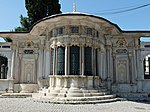
Sebil of the Mihrişah Sultan Circuitous, with side fountains
-

Eyüp Sultan Mosque interior
-

Tomb and courtyard of the Emir Sultan complex in Bursa
-

Selimiye Mosque in Üsküdar, Istanbul (1801–1805): view of the front façade and entrance portico
-

Selimiye Mosque: side view with external gallery and role of the majestic pavilion (right)
-

Interior of Selimiye Mosque
-
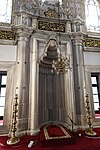
Mihrab of the Selimiye Mosque
-

Selimiye Billet in Üsküdar, originally built by Selim III (circa 1803) just rebuilt by Mahmud 2
Palace compages in the Baroque flow [edit]

Bizarre decoration on the outside of the Imperial Council (Divan) Hall in Topkapı Palace
In Topkapı Palace the Ottoman sultans and their family continued to build new rooms or remodel old ones throughout the 18th century, introducing Baroque and Rococo decoration in the process. The principal baths of the Harem section, which served the sultan and the valide sultan (queen mother), were probably renovated by Mahmud I around 1744, providing them with their electric current Baroque decoration.[110] [111] In 1752 Mahmud I restored the Sofa Kiosk (Sofa Köşkü) in Rococo style. This kiosk is a garden pavilion in the Quaternary Court that was commencement begun in the late 17th century by Mustafa Pasha and so either completed or restored by Ahmet Iii in 1704.[112] [113] [114] [115] Within the Harem section, either Osman III or Abdulhamid I renovated the Purple Hall (Hünkâr Sofası), adding among other things a Baroque wall fountain and Dutch blueish-and-white tiles (although the ornamentation of the dome has since been restored to its late 16th-century state).[116] [117] The Kiosk of Osman 3, completed in 1754-55, is one of the most notable additions of this era. Information technology was built over a masonry substructure that extends backside the Imperial Hall, with a marble terrace filling the space between them. The terrace includes flowerbeds and a fundamental water basin, while a private passage on the westward side grants access between the kiosk and the palace. The terrace façade of the kiosk includes a wide undulating eave. The kiosk itself is made of wood and consists of several rooms, with the main room in the middle projecting out over the edge of the palace walls to provide wider views. Its interior is heavily decorated with Baroque and Rococo decoration, including golden carvings and trompe-l'oeil paintings of architectural scenes.[118] [119] [120] [114] [117] Abdulhamid I and Selim III later added lavishly-decorated Rococo apartments in this area likewise, along with a rich apartment upstairs for Mihrişah Sultan, the mother of Selim III.[121] [117] Osman III also renovated the prayer room of the women's section in the Harem, providing information technology with a stone-carved Baroque mihrab.[122] The School of Princes was also redecorated in the mid 18th century.[123] Among the most elaborately-decorated elements in the Schoolhouse'southward classroom and in the many individual apartments are the fireplaces.[124] The Regal Quango (Divan) Hall in the Second Court of the palace was redecorated in flamboyant Baroque style by Selim III in 1792 and by Mahmud 2 in 1819.[125]

As in the preceding centuries, other palaces were built around Istanbul by the sultan and his family. Previously, the traditional Ottoman palace configuration consisted of different buildings or pavilions bundled in a group, as was the case at Topkapı Palace, the Edirne Palace, the Kavak or Üsküdar Palace (at Salacak), the Tersane Palace, and others.[126] However, at some time during the 18th century there was a transition to palaces consisting of a unmarried block or a unmarried large edifice. This tendency may have been popularized by the sisters of Selim Three in the tardily 18th century.[127] Ane of his sisters, Hadice Sultan (d. 1822), had a grand shoreline palace at Defterdarburnu (near Ortaköy) on the Bopshorus. In the 1790s she commissioned Antoine Ignace Melling to add together a European Neo-Classical pavilion to the palace.[128] Along with the palace of Beyhan and Esma Sultan on the Golden Horn, her palace may have been one of the first Ottoman palaces to consist of a single block stretching along the shoreline.[129] Most of these palaces have not survived to the present mean solar day. Among the rare surviving examples, Bizarre decoration from this period can however exist seen in the Aynalıkavak Pavilion (mentioned in a higher place), which was restored past Selim III and Mahmud Two.[130]
Beyond Istanbul the greatest palaces were built by powerful local families, simply they were frequently built in regional styles that did not follow the trends of the Ottoman capital.[131] The Azm Palace in Damascus, for example, was built around 1750 in a largely Damascene fashion.[131] [132] The Azm family unit also had a major palace in Hama.[131] In eastern Anatolia, near present-day Doğubayazıt, the Ishak Pasha Palace is an exceptional and flamboyant piece of compages that mixes various local traditions including Seljuk Turkish, Armenian, and Georgian. It was begun in the 17th century and by and large completed by 1784.[133] [134] [135]
- Bizarre architecture in Topkapı Palace
-
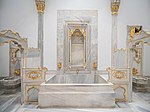
Baths of the Sultan and Queen Female parent, Topkapı Palace, renovated circa 1744 past Mahmud I
-
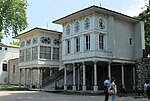
Sofa Kiosk, Topkapı Palace, restored by Mahmud I in 1752
-

Interior of Sofa Kiosk restored by Mahmud I in 1752
-
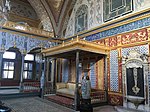
Baroque ornament in the Imperial Hall in the Harem of Topkapı Palace (18th century)
-

Partial view of the Kiosk of Osman III in the Harem of Topkapı Palace (1754–1755)
-

Mihrab of the prayer room in the Harem of Topkapı Palace, added in Osman III's restoration (1754–1757)
Tardily Baroque monuments under Mahmud II [edit]
The Tomb of Nakşidil Sultan (female parent of Mahmud Ii), built in 1818 near the Fatih Mosque circuitous in Istanbul, is one of the finest Ottoman Baroque tombs and one of the best examples of late Bizarre monuments.[136] [137] Some details think the earlier Şah Sultan Tomb, such as the elliptical windows above.[136] It also incorporates some influence from the Empire style, which was being introduced in Istanbul around this fourth dimension.[138] The tomb was designed past the Ottoman Armenian architect Krikor Balian.[139] Some of the Baroque mosques from this period characteristic elliptical domes, such equally the small single-domed Küçük Efendi (or Fevziye) Mosque in Istanbul (1825) and the multi-domed Kapı Mosque in Konya (1812).[140]
The Nusretiye Mosque, Mahmud Ii's imperial mosque, was built between 1822 and 1826 at Tophane. Its name commemorates the "victory" which Mahmud Ii won by destroying the Janissaries in 1826, the year of the mosque's completion.[141] [142] Mahmud Two also congenital a new artillery barracks and parade ground near the mosque at the same time, replacing the billet of Selim Three which had been destroyed by the Janissaries, thus continuing Tophane's association with the historic period of reforms initiated by Selim III.[99] [141] The mosque is the commencement major majestic work by Krikor Balian.[141] [143] Information technology is sometimes described as belonging to the Empire fashion, but is considered by Godfrey Goodwin and Doğan Kuban every bit 1 of the last Baroque mosques.[141] [144] John Freely describes it as a mix of Baroque and Empire styles,[145] while Ünver Rüstem describes the fashion as moving abroad from the Baroque and towards an Ottoman estimation of Neoclassicism.[143] Goodwin likewise describes it as the last in a line of imperial mosques that started with the Nuruosmaniye.[141] The mosque follows the model of Selim Iii'due south imperial mosque in Üsküdar, every bit seen in some of its details and in the portico and double-winged imperial pavilion fronting the mosque.[142] [146] [144] The mosque was innovative in other details such equally the greater use of vaults and stairways, the utilize of forest instead of stone for elements like stairs, and in the ornamentation of the dome where the traditional circular Arabic inscription is replaced with a vegetal foliate motif.[147] Despite its relatively small size the mosque'due south tall proportions creates a sense of acme, which may the culmination of a trend that began with the Ayazma Mosque.[148] From the outside, the mosque'due south about notable details are the farthermost slenderness of its minarets[149] [148] and its two Rococo sebils which take flamboyantly undulating surfaces.[148]
- Bizarre monuments nether Mahmud II
-
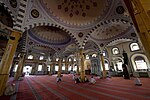
Kapı Mosque in Konya (1812)
-
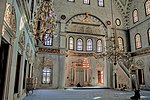
Interior of the Nusretiye Mosque
-

Decoration of the dome of the Nusretiye Mosque (before most contempo restoration)
-

One of the sebils of the Nusretiye Mosque
-

1830s illustration of the Tophane Billet congenital by Mahmud Two (with the Nusretiye Mosque behind)
Bizarre and local architecture in the provinces [edit]
Information technology was only in the 1750s that the Ottoman Baroque style began to announced outside Istanbul.[53] The Cihanoğlu Mosque in Aydın (1756), mentioned above, is among the early examples.[53] During the reign of Abdülhamid I 2 notable provincial mosques were built in Bizarre style in Anatolia: the Kurşunlu Mosque in Gülşehir (1779) and the Çapanoğlu Mosque in Yozgat (1778, expanded in 1795).[150] Another example during the reign of Selim III is the Izzet Pasha Mosque in Safranbolu (1796).[151]
In Athens, one pocket-size mosque survives from this menses: the Dizdar Mustafa Mosque or Mosque of Tzistarakis from 1763–1764.[152] [153] On the island of Rhodes, the Sultan Mustafa Mosque, built in 1764 for Mustafa Iii, has a tall single-dome design that reflects the trends of 18th-century mosques in Istanbul.[154] In Shumen, present-day Bulgaria, the Sherif Halil Pasha Mosque Complex (or Tombul Mosque), congenital in 1744–1745, is ane of the few notable constructions in the Balkan region during this period. In addition to the mosque, the circuitous includes a madrasa, a library, and a main school. Its mode, even so, resembles more strongly that of the earlier Damat Ibrahim Pasha Mosque in Nevşehir and its decoration recalls that of the Tulip Menstruum.[155] [156]

In more than distant provinces in the Heart East and Due north Africa, local styles continued to be employed with greater independence, as they already were in the 16th and 17th centuries.[157] In Syrian arab republic, internecine conflicts caused great impairment to the country during the 18th century, only the cities of Damascus and Aleppo remained prosperous commercial centers.[158] [159] Damascus, the provincial capital, benefitted from the long and relatively capable governance of the 'Azm family. New palaces, caravanserais, hammams, and madrasas were congenital. In contrast with earlier caravanserais, which were centered around the traditional open courtyard, the multiple new caravanserais built in Damascus during this century embraced the Ottoman predilection for domes and featured domed central spaces.[158] The most spectacular and admired building of this kind is the Khan As'advert Pasha (1753), whose principal hall consists of nine domes supported past iv central pillars.[158] [160]
In Cairo, several rare monuments sponsored by Ottoman sultans were congenital in the mid-18th century, demonstrating a certain level of renewed purple involvement in this provincial capital.[161] The Takiyya Mahmudiyya, sponsored past Mahmud I and dated to 1750, was the first Ottoman complex in Cairo to be founded past a sultan, over two and a one-half centuries after the conquest of the city. It consists of a madrasa and a sabil-kuttab (a combination of sebil and primary school). The style and ornament of the complex is a fusion of Ottoman and local Cairene (Mamluk) styles, just it does not include any elements of the new Bizarre fashion Mahmud I was employing in Istanbul.[161] [162] A slightly afterward imperial foundation, the Sabil-kuttab of Mustafa III in Cairo (located beyond from the Mosque of Sayyida Zeinab) in 1758–1760, even so demonstrates local Cairene influences but this time it incorporates some new Baroque details.[161] [163] (Another sabil-kuttab founded by Mustafa III near the Mosque of Sayyida Nafisa in 1756–1757 has not been preserved.[161]) Other 18th-century buildings sponsored by local elites were generally built in an Ottoman-Mamluk hybrid way, such as the Sabil-kuttab of Abd ar-Rahman Katkhuda (1744). While Mamluk-era configurations remained predominant, Ottoman ornament was applied in highly visible ways in some local monuments, almost notably in the utilize of Ottoman blue and white tiles, including re-used 16th-century Iznik tiles imported from Istanbul.[161] The nearly influential innovation of Mahmud I'southward complex was the curved façade of its sabil-kuttab, a local interpretation of the curved sebil facades in Istanbul, which was repeated in subsequent sabil-kuttab designs in Cairo.[161] In the 19th century, under the de facto independent dominion of Muhammad Ali and his successors, Ottoman Baroque and gimmicky tardily Ottoman Westernizing ornamentation was conspicuously employed in new buildings, including the Mosque of Muhammad Ali (1830–1848) in the Citadel and several sabil-kuttabs throughout the city.[164] [165]
Beyond Istanbul the greatest palaces were built by powerful local families, only they were often built in regional styles that did not follow the trends of the Ottoman upper-case letter.[131] The Azm Palace in Damascus, for instance, was built around 1750 in a largely Damascene style.[131] [132] The Azm family unit besides had a major palace in Hama.[131] In eastern Anatolia, near present-day Doğubayazıt, the Ishak Pasha Palace is an exceptional and flamboyant piece of architecture that mixes various local traditions including Seljuk Turkish, Armenian, and Georgian. It was begun in the 17th century and generally completed by 1784.[133] [134] [135]
- 18th-century architecture in the provinces
-
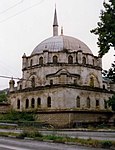
-

Sabil-kuttab of Mustafa III (1758–1760), featuring some of the first Ottoman Baroque details in Cairo
-

-
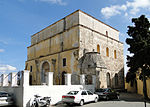
Remains of the Sultan Mustafa Three Mosque in Rhodes (1764)
-

-

Sabil of Isma'il Pasha (1828) with Baroque and late Ottoman decoration typical of 19th-century Cairo
Ottoman architecture after the Bizarre [edit]
The subsequently reign of Mahmud 2 as well saw the introduction of the Empire style, a Neoclassical style which originated in France under Napoleon, into Ottoman compages.[166] This marked a tendency towards increasingly direct imitation of Western styles, particularly from French republic.[138] Ottoman Bizarre motifs and forms connected to be used during the 19th century, but they were ofttimes employed alongside other styles.[4] The Tanzimat reforms that began in 1839 under Abdülmecid I sought to modernize the Ottoman Empire with Western-style reforms. In the architectural realm this period resulted in the dominance of European architects and Ottoman architects with European training.[167] Among these, the Balians, an Ottoman Armenian family, succeeded in dominating purple architecture for much of the century. They were joined past European architects such as the Fossati brothers, William James Smith, and Alexandre Vallaury.[168] [169] Afterward the early 19th century Ottoman architecture was characterized by an eclectic architecture which mixed or borrowed from multiple styles. The Balians, for example, commonly combined Neoclassical or Beaux-arts architecture with highly eclectic ornamentation.[170] Later trends involving Orientalist designs and Ottoman revivalism, initially encouraged by European architects similar Vallaury, eventually led to the First National Architecture motion which, alongside Art Nouveau, dominated architecture in the last years of the Ottoman Empire in the early on 20th century.[171]
Scholarly views on the Ottoman Baroque [edit]
Scholarly attitudes towards the Ottoman Baroque and towards afterward Ottoman compages have varied over fourth dimension and from one author to another. Many scholars have traditionally framed post-Classical Ottoman architecture equally a symbol of Ottoman turn down and cultural insecurity vis-à-vis Europe, lacking merit in comparison with before Ottoman architecture.[172] This attitude has been progressively revised since the subsequently twentieth century.[173] Turkish scholar Doğan Kuban has argued that even though it was directly influenced past the European Bizarre the Ottoman Baroque reflects a local interpretation of the style that became its own distinctive ethnic fashion.[viii] [174] More than contempo scholars similar Tulay Artan and Shirine Hamadeh accept argued for a more positive evaluation of the fashion and for a lesser accent on the role of Western influence.[175] In a 2019 volume Ünver Rüstem argues that 18th-century Ottoman culture and compages should exist contextualized within the attitudes of Ottoman elites at the time, who saw their empire every bit an integral office of Europe and adjusted ideas from the Westward insofar equally they were deemed useful, as well as contextualized within the Early on Modern trends that were taking place on a more global scale.[176]
References [edit]
- ^ Rüstem 2019, p. 21.
- ^ a b 1000. Bloom, Jonathan; S. Blair, Sheila, eds. (2009). "Architecture; VII. c. 1500–c. 1900". The Grove Encyclopedia of Islamic Art and Architecture. Oxford University Press. ISBN9780195309911.
- ^ a b c Rüstem 2019, pp. 21–22.
- ^ a b Kuban 2010.
- ^ Kuban 2010, pp. 517–518.
- ^ a b Kuban 2010, p. 517.
- ^ Kuban 2010, p. 507.
- ^ a b Kuban 2010, p. 505.
- ^ Goodwin 1971.
- ^ Rüstem 2019, p. 260.
- ^ Rüstem 2019, pp. 64–65.
- ^ Rüstem 2019, p. 68.
- ^ Rüstem 2019, p. seventy.
- ^ Goodwin 1971, pp. 375–376.
- ^ Rüstem 2019, pp. 70–73.
- ^ Goodwin 1971, pp. 377–379.
- ^ Rüstem 2019, p. 64.
- ^ Kuban 2010, p. 518.
- ^ a b Kuban 2010, p. 526.
- ^ Rüstem 2019, p. 111.
- ^ Rüstem 2019, p. 115.
- ^ Goodwin 1971, p. 386.
- ^ Kuban 2010, p. 527.
- ^ a b Rüstem 2019, p. 147.
- ^ Rüstem 2019, p. 122, 138.
- ^ "Nuruosmaniye Mosque - Find Islamic Art - Virtual Museum". islamicart.museumwnf.org . Retrieved 2021-08-28 .
- ^ a b Kuban 2010, p. 532.
- ^ Rüstem 2019, p. 137.
- ^ Rüstem 2019, pp. 138–145.
- ^ Kuban 2010, pp. 532, 536.
- ^ Rüstem 2019, pp. 139–140.
- ^ Rüstem 2019, p. 138.
- ^ Rüstem 2019, pp. 141–144.
- ^ Rüstem 2019, pp. 144–145.
- ^ Rüstem 2019, p. 145.
- ^ Rüstem 2019, p. 146.
- ^ a b Goodwin 1971, p. 388.
- ^ Kuban 2010, pp. 528–529.
- ^ Rüstem 2019, pp. 112–113.
- ^ Goodwin 1971, p. 382.
- ^ a b Kuban 2010, p. 536.
- ^ Rüstem 2019, pp. 128–130.
- ^ Rüstem 2019, p. 125.
- ^ Rüstem 2019, pp. 125–128.
- ^ Rüstem 2019, pp. 126–130.
- ^ a b Kuban 2010, p. 537.
- ^ a b Goodwin 1971, p. 387.
- ^ Rüstem 2019, p. 172.
- ^ a b Rüstem 2019, p. 174.
- ^ Rüstem 2019, p. 176.
- ^ Goodwin 1971, pp. 387, 418.
- ^ Kuban 2010, p. 543.
- ^ a b c Rüstem 2019, p. 180.
- ^ Ekinci, Ekrem Buğra (2016-x-21). "Birdhouses: Miniature mansions of Istanbul". Daily Sabah . Retrieved 2021-09-21 .
- ^ Rüstem 2019, p. 182.
- ^ a b Kuban 2010, p. 540.
- ^ Kuban 2010, pp. 540–541.
- ^ Rüstem 2019, p. 186.
- ^ a b Kuban 2010, p. 541.
- ^ Rüstem 2019, pp. 190–191.
- ^ Rüstem 2019, pp. 194–195.
- ^ Rüstem 2019, p. 185.
- ^ a b Goodwin 1971, p. 391.
- ^ Rüstem 2019, p. 184.
- ^ Sumner-Boyd & Freely 2010, p. 166.
- ^ Rüstem 2019, pp. 195–196, 198–200.
- ^ Rüstem 2019, pp. 199–200.
- ^ Rüstem 2019, p. 200.
- ^ Rüstem 2019, pp. 198–200.
- ^ Rüstem 2019, pp. 212–214.
- ^ Rüstem 2019, p. 215.
- ^ a b Goodwin 1971, p. 396.
- ^ Kuban 2010, pp. 537, 544.
- ^ Rüstem 2019, pp. 234–235.
- ^ Goodwin 1971, pp. 397–398.
- ^ Rüstem 2019, p. 236.
- ^ a b Goodwin 1971, p. 397.
- ^ Rüstem 2019, pp. 236–237.
- ^ Goodwin 1971, pp. 398–399.
- ^ a b Rüstem 2019, p. 223.
- ^ a b Rüstem 2019, p. 225.
- ^ Rüstem 2019, p. 226.
- ^ Rüstem 2019, p. 230.
- ^ a b c Goodwin 1971, p. 411.
- ^ Kuban 2010, p. 546.
- ^ Kuban 2010, pp. 546–548.
- ^ Rüstem 2019, p. 252.
- ^ Sumner-Boyd & Freely 2010, p. 365.
- ^ Goodwin 1971, p. 412.
- ^ Rüstem 2019, p. 254.
- ^ Sumner-Boyd & Freely 2010, p. 366.
- ^ Rüstem 2019, p. 253.
- ^ Kuban 2010, p. 520.
- ^ Kuban 2010, pp. 548–550.
- ^ Kuban 2010, p. 552.
- ^ Rüstem 2019, pp. 247, 254.
- ^ Rüstem 2019, pp. 254–255.
- ^ Rüstem 2019, p. 255.
- ^ a b c d due east f Kuban 2010, p. 554.
- ^ a b Rüstem 2019, p. 248.
- ^ Rüstem 2019, p. 257.
- ^ Rüstem 2019, p. 264.
- ^ a b Kuban 2010, p. 555.
- ^ Goodwin 1971, p. 420.
- ^ a b c Rüstem 2019, p. 256.
- ^ Rüstem 2019, pp. 258–260.
- ^ Rüstem 2019, pp. 259–260.
- ^ Kuban 2010, p. 545.
- ^ Rüstem 2019, pp. 258–259.
- ^ Rüstem 2019, pp. 98–99.
- ^ Sumner-Boyd & Freely 2010, p. 79.
- ^ Sumner-Boyd & Freely 2010, p. 76.
- ^ Rüstem 2019, p. 99.
- ^ a b Goodwin 1971, p. 393.
- ^ Kuban 2010, pp. 430, 435.
- ^ Rüstem 2019, p. 238.
- ^ a b c Freely 2011, p. 177. sfn fault: no target: CITEREFFreely2011 (assistance)
- ^ Rüstem 2019, pp. 158–159.
- ^ Kuban 2010, pp. 435–436.
- ^ Atasoy 2011, p. 58.
- ^ Atasoy 2011, pp. 64, 71.
- ^ Rüstem 2019, p. 159.
- ^ Freely 2011, p. 173. sfn error: no target: CITEREFFreely2011 (aid)
- ^ Goodwin 1971, pp. 392–393.
- ^ Rüstem 2019, pp. 242–243, 261.
- ^ Kuban 2010, p. 437.
- ^ Kuban 2010, pp. 437–438.
- ^ Rüstem 2019, pp. 255–256.
- ^ Kuban 2010, p. 438.
- ^ Sumner-Boyd & Freely 2010, p. 363.
- ^ a b c d e f Goodwin 1971, p. 404.
- ^ a b "Qasr al-Azm - Discover Islamic Art - Virtual Museum". islamicart.museumwnf.org . Retrieved 2021-08-28 .
- ^ a b Goodwin 1971, pp. 404–407.
- ^ a b Kuban 2010, pp. 583–584.
- ^ a b "İshak Paşa Palace - Discover Islamic Art - Virtual Museum". islamicart.museumwnf.org . Retrieved 2021-08-28 .
- ^ a b Goodwin 1971, p. 416.
- ^ Kuban 2010, p. 550.
- ^ a b Kuban 2010, p. 605.
- ^ Kuban 2010, p. 610.
- ^ Goodwin 1971, pp. 414–415.
- ^ a b c d east Goodwin 1971, p. 417.
- ^ a b Rüstem 2019, p. 269.
- ^ a b Rüstem 2019, p. 270.
- ^ a b Kuban 2010, p. 631.
- ^ Freely 2011, p. 399. sfn error: no target: CITEREFFreely2011 (help)
- ^ Goodwin 1971, pp. 417–418.
- ^ Goodwin 1971, pp. 418–419.
- ^ a b c Goodwin 1971, p. 418.
- ^ Sumner-Boyd & Freely 2010, p. 417.
- ^ Goodwin 1971, pp. 400–401.
- ^ Goodwin 1971, p. 402.
- ^ Kiel, Machiel. "Athens". In Fleet, Kate; Krämer, Gudrun; Matringe, Denis; Nawas, John; Rowson, Everett (eds.). Encyclopaedia of Islam, Iii. Brill. ISSN 1873-9830.
- ^ "ATİNA - TDV İslâm Ansiklopedisi". TDV İslam Ansiklopedisi (in Turkish). Retrieved 2022-03-08 .
- ^ Kuban 2010, p. 594.
- ^ Kuban 2010, pp. 592–593.
- ^ "ŞERİF HALİL PAŞA KÜLLİYESİ - TDV İslâm Ansiklopedisi". TDV İslam Ansiklopedisi (in Turkish). Retrieved 2022-03-07 .
- ^ Blair & Flower 1995, p. 251-255.
- ^ a b c Degeorge, Gérard (2004). Damascus. Flammarion. pp. 192–198. ISBN2080304569.
- ^ Kuban 2010, p. 586.
- ^ Burns, Ross (2007). Damascus: A History. Routledge. p. 244. ISBN978-i-134-48850-half dozen.
- ^ a b c d eastward f Behrens-Abouseif, Doris (2011). "The Circuitous of Sultan Mahmud I in Cairo". Muqarnas. 28: 195–220. doi:ten.1163/22118993-90000178.
- ^ Rüstem 2019, p. 288 (note 18).
- ^ Rüstem 2019, p. 180-181.
- ^ Behrens-Abouseif, Doris (1989). Islamic Architecture in Cairo: An Introduction. Leiden, the Netherlands: E.J. Brill. pp. 167–170. ISBN9789004096264.
- ^ Williams, Caroline (2018). Islamic Monuments in Cairo: The Applied Guide (7th ed.). Cairo: The American University in Cairo Press. pp. 138, 194, 226, 240.
- ^ Kuban 2010, pp. 505–506, 605.
- ^ Kuban 2010, p. 605 and after.
- ^ Kuban 2010, pp. 609–612.
- ^ Goodwin 1971, p. 419.
- ^ Kuban 2010, pp. 605–606.
- ^ Kuban 2010, pp. 606, 614, 673–676.
- ^ Rüstem 2019, p. meet "Introduction".
- ^ Rüstem 2019, p. 5 and after.
- ^ Rüstem 2019, p. 6-vii.
- ^ Rüstem 2019, p. 8-nine.
- ^ Rüstem 2019, p. nine and subsequently.
Bibliography [edit]
- Acun, Hakkı (2011). Osmanlı İmparatorluğu Saat Kuleleri. Ankara: Atatürk Kültür Merkezi Yayınları. ISBN9789751623706.
- Atasoy, Nurhan (2011). Harem. Bilkent Kültür Girişimi Publications. ISBN9786055495060.
- Blair, Sheila South.; Bloom, Jonathan M. (1995). The Art and Compages of Islam 1250-1800. Yale University Press. ISBN9780300064650.
- Freely, John (2011). A History of Ottoman Architecture. WIT Printing. ISBN978-1-84564-506-9.
- Goodwin, Godfrey (1971). A History of Ottoman Architecture. Thames & Hudson. ISBN0-500-27429-0.
- Kuban, Doğan (2010). Ottoman Architecture. Translated by Mill, Adair. Antique Collectors' Club. ISBN9781851496044.
- Rüstem, Ünver (2019). Ottoman Baroque: The Architectural Refashioning of Eighteenth-Century Istanbul. Princeton University Press. ISBN9780691181875.
- Sumner-Boyd, Hilary; Freely, John (2010). Strolling Through Istanbul: The Archetype Guide to the City (Revised ed.). Tauris Parke Paperbacks.
tolberttwoult1944.blogspot.com
Source: https://en.wikipedia.org/wiki/Ottoman_Baroque_architecture
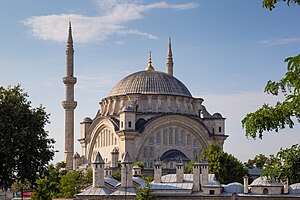


0 Response to "Art in the Ottoman Empire in the 17 Century"
Post a Comment